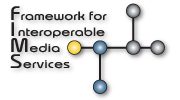PROJECTS
The AMWA develops specifications and technologies to facilitate the deployment and operation of efficient media workflows. The AMWA works closely with standards bodies like the SMPTE.
To make sure that projects are clearly defined, adequately resourced and successful, we have a formal process to carefully manage proposals from start to finish. We welcome all new ideas to advance the use of file based workflows. If you think that your organization could benefit from our skills and experience, please use the links below to learn more.
Project Process Policy (pdf, 385k)
Project Proposal Template (pdf, 32k)
Technical work of the association is through projects that strive for compatibility between AAF (Advanced Authoring Format), BXF, MXF (Material Exchange Format) and XML. The current projects fall into three categories: data models, interface specifications, and application specifications.
View all AMWA Projects
 Networked Media Incubator project | View NMI project
Networked Media Incubator project | View NMI project
AMWA's Networked Media Incubator (NMI) is a project to deliver a framework for IP based media systems using interoperable and open specifications for end-to-end identity, media transport, timing, discovery & registration, connection management and control. The project will also examine methods to expose and interact with compositions of media assets, such as during an edit or a delivery workflow.
The aim is for the industry to provide IP systems that preserve content identity and metadata from cameras, through production systems, on to audiences and archive. This will allow media companies to define and maintain relationships between production assets, unlock new workflows and content formats, and deliver richer, customizable content propositions on today's emerging platforms.
The project will build upon the work of the EBU/VSF/SMPTE Joint Task Force for Networked Media (JT-NM) by taking a practical approach to implement aspects of the JT-NM Reference Architecture model through clearly scoped inter-operation and development workshops, to enable participants to deliver tools suitable for an 'Internet-first' media industry.
Application Specifications | View Application Specifications
Applications Specifications define a set of rules that constrain a standard—like MXF—to suit a specific application. Each has been created to satisfy the clearly defined operational need of a member company. The list grows continuously. Currently, the specifications include:
- Program Mastering when there are multiple versions of the content (AS-02)
- Program Delivery to multiple broadcast stations (AS-03)
- Archive and Preservation of a wide range of material (AS-07)
- Workflows suited to fast turnaround end-to-end production (AS-10)
- Media Contribution for the delivery of finished media assets to a broadcaster or publisher (AS-11)
- The use of metadata for the management of content, including a unique identifier (AS-12)
Although first designed to meet a known requirement, a specification can be updated, either because the original user has refined their needs or because a new member wishes to capitalise on the previous work and slightly extend the capabilities of the specification.
Data Models | View Data Models
The data models lie at the heart of the media workflow technologies.
Interface Specifications | View Interface Specifications
The interface specifications are used to create interoperation between equipment and applications in the media workflow.
 FIMS | View FIMS Projects
FIMS | View FIMS Projects
FIMS project is a joint project of the AMWA and the European Broadcasting Union. The AMWA Media Services Architecture Group (MSAG), was responsible for providing information on architectures and best practices for enterprise-level software technology in digital media workflows. The work of MSAG group led to the formation of the jointly-sponsored FIMS project.
Any company can join and participate in the FIMS project. It is free, doesn’t require membership in AMWA or EBU. The only requirement is to sign a FIMS Participation Agreement. Find more information on the FIMS Wiki.


